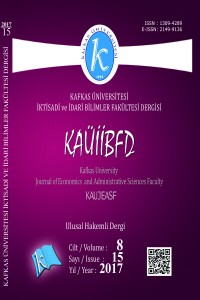Öz
Bu çalışmanın amacı Türkiye’de, ekonominin üç temel
sektörü olan sanayi, hizmet ve tarım sektörlerinin gerek birbirleriyle gerekse
gayri safi yurtiçi hasıla (GSYİH) ile olan kısa ve uzun dönem etkileşimlerini
zaman serisi yöntemleriyle ortaya koymaktır. Çalışmada kullanılan veriler üçer
aylık olup 1998:I-2015:IV dönemini kapsamaktadır. Değişkenler arasındaki uzun
dönem dinamik ilişkileri araştırmak için Gecikmesi Dağıtılmış Otoregresif
(ARDL) sınır testi yaklaşımı kullanılmıştır. Ardından, Toda-Yamamoto nedensellik
testi ile söz konusu değişkenler arasındaki nedensel ilişkiler belirlenmiştir.
ARDL sınır testi sonucunda, tarım
sektörü üretiminin bağımsız değişken olduğu modeller hariç tüm ikili
değişkenler arasında uzun dönem ilişki tespit edilmiştir. Toda-Yamamoto
nedensellik testi sonuçları, GSYİH ile sanayi üretimi arasında ve GSYİH ile
hizmet üretimi arasında çift yönlü, hizmet sektörü üretiminden sanayi üretimine
doğru olmak üzere tek yönlü bir nedensellik ilişkisi olduğunu göstermiştir.
Anahtar Kelimeler
Kaldor yasası sektörel dinamikler ARDL sınır testi yaklaşımı
Kaynakça
- Arısoy, İ. (2013). Kaldor yasası çerçevesinde Türkiye’ de sanayi sektörü ve iktisadi büyüme ilişkisinin sınanması. Eskişehir Osmangazi Üniversitesi İİBF Dergisi, 8(1), 143-162.
- Ateşoğlu, H. S. (1993). Manufacturing and economic growth in the United States. Applied Economics, 25(1), 67-69.
- Bairam, E. (1987). The verdoorn law, returns to scale and ındustrial growth: a review of the literature. Australian Economic Papers, 26(48), 20-42.
- Bairam, E. (1991). Economic growth and kaldor’s law: the case of turkey, 1925-78. Applied Economics, 23(8), 1277-1280.
- Cornwall, J. (1976). Diffusion, convergence and Kaldor’s laws. The Economic Journal, 86(342), 307-314.
- Cornwall, J. (1977). Modern capitalism: Its growth and transformation. London: Martin Robertson.
- Çetin, M. (2009). Kaldor büyüme yasasının ampirik analizi: Türkiye ve AB ülkeleri örneği (1981-2007). Afyon Kocatepe Üniversitesi İ.İ.B.F.Dergisi, C.XI, S I, 355-373.
- Diaz Bautista, A. (2003). Mexico’s industrial engine of growth: Cointegration and causality. Momento Economico, 126, 34-41.
- Dickey, D.A., & Fuller, W.A. (1979). Distribution of the estimators for autoregressive time series with a unit root. Journal of the American Statistical Association, 74(366), 427–431.
- Dickey, D.A., & Fuller, W.A. (1981). Likelihood ratio statistics for autoregressive time series with a unit root. Econometrica, 49 (4), 1057-1072.
- Dixon, R., & Thirlwall, A.P. (1975). A model of regional growth-rate differences on kaldorian lines. Oxford Economic Papers, 27(2), 201-214.
- Drakopoulos, S.A., & Theodessiou, I. (1991). Kaldorian approach to greek economic growth. Applied Economics, 23(10), 1683-1689.
- Engle, R.F., & Granger, C.W.J. (1987). Co-integration and error correction: Representation, estimation, and testing. Econometrica, 55(2), 251-276.
- Gramlich, E. (1994). Infrastructure investment: A review essay. Journal of Economic Literature, 32(3), 1179-1196
- Güçlü, M. (2013). Manufacturing and regional economic growth in Turkey: A spatial econometric view of Kaldor’s laws. European Planning Studies, 21(6), 854-866.
- Johansen, S. (1988). Statistical analysis of cointegration vectors. Journal of Economic Dynamics and Control, 12(2-3), 231-254.
- Johansen, S., & Juselius, K. (1990). Maximum likelihood estimation and ınference on cointegration with applications to the demand for money. Oxford Bulletin of Economics and Statistics, 52(2), 169-210.
- Kaldor, N. (1966). Causes of the slow rate of growth of the United Kingdom. Cambridge: Cambridge University Press.
- Kaldor, N. (1968). Productivity and growth in manufacturing industry: A Reply. Economica, 35(140), 385-391.
- Levine, R. (1997). Financial development and economic growth: Views and agenda. Journal of Economic Literature, 35(2), 688-726.
- Libanio, G., & Moro, S. (2006). Manufacturing industry and economic growth in Latin America: A Kaldorian approach. Paper Presented at the Second Annual Conference for Development and Change.
- Mercan, M., & Kızılkaya, O. (2014). Türkiye’de sanayi sektörü ekonomik büyüme ve verimlilik ilişkisinin kaldor yasaları çerçevesinde sınanması: Ekonometrik Bir Analiz. Marmara Üniversitesi İ.İ.B. Dergisi, 36 (1), 137-160.
- Millin, M., & Nichola, T. (2005). Explaining economic growth in South Africa: A Kaldorian approach. International Journal of Technology Management and Sustainable Development, 4(1), 47-62.
- Munnell, A. (1992). Policy watch, infrastructure investment and economic growth. Journal of Economic Perspectives, 6(4), 189-198.
- Necmi, S. (1999). Kaldor’s growth analysis revisited. Applied Economics, 31(5), 653-660.
- Pesaran, M.H., & Shin, Y. (1999), An autoregressive distributed lag modelling approach to cointegration analysis. S. Strom (Ed.) Econometrics and economic theory in the 20th Century: the Ragnar Frisch centennial symposium. Cambridge: Cambridge University Press.
- Pesaran, M.H., Shin, Y., & Smith, R.J. (2001). Bounds testing approaches to the analysis of level relationships. Journal of Applied Econometrics, 16(3), 289-326.
- Pradhan, R.P., & Bagchi, T.P. (2013). Effect of transportation infrastructure on economic growth in India: The VECM approach. Research in Transportation Economics, 38, 139-148.
- Stoneman, P. (1979). Kaldor’s law and British economic growth: 1800-1970. Applied Economics, 11(3), 309-319.
- Toda, H.Y., & Yamamoto, T. (1995). Statistical inference in vector autoregressions with possibly integrated processes. Journal of Econometrics, 66(1-2), 225-250.
- Yamak, N. (2000). Cointegration, causality and Kaldor’s hypothesis: Evidence from Turkey, 1946-1995. G. Ü. İ.İ.B.F. Dergisi, 2(1), 75-80.
- Yamak, R., & Sivri, U. (1997). Ekonomik büyüme ve Kaldor yasası: Türkiye örneği, 1979-1994. İktisat, İşletme ve Finans, 12(139), 9-21.
- Yamak, R., Erdem, H.F., & Koçak, S. (2016). A re-examination of Kaldor’s engine of economic growth hypothesis for the Turkish economy. Acta Universitatis Danubius Œconomica, 12(4), 347-357.
- Zivot, E., & Andrews, D.W.K. (1992). Further evidence on the great crash, the oil price shock, and the unit root hypothesis. Journal of Business & Economic Statistics, 10(3), 251-270.
Ayrıntılar
| Birincil Dil | Türkçe |
|---|---|
| Bölüm | Makaleler |
| Yazarlar | |
| Yayımlanma Tarihi | 8 Temmuz 2017 |
| Yayımlandığı Sayı | Yıl 2017 Cilt: 8 Sayı: 15 |
KAÜİİBFD, Kafkas Üniversitesi İktisadi ve İdari Bilimler Fakültesi Dergi Yayıncılığı'nın kurumsal dergisidir.
KAÜİİBFD 2022 yılından itibaren Web of Science'a dahil edilerek, Clarivate ürünü olan Emerging Sources Citation Index (ESCI) uluslararası alan endeksinde taranmaya başlamıştır.
2025 Haziran ve Aralık sayısı İşletme alanı kotası dolmuştur. Bir sonraki duyuruya kadar İşletme alanındaki gönderiler değerlendirmeye alınmayacaktır. Dergimizin kapsamındaki diğer alanların makale kabul ve değerlendirmeleri devam etmektedir.


